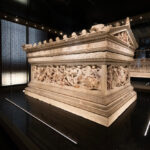Manger Mausoleum
Classical
Julius Manger
1868–March 28th, 1937
Julius Manger was born in Boonville, Missouri. He and his brother William became involved with building construction in Galveston and later located the hub of their activities in New York City. Their entry into the New York real estate market was the construction of more than 500 homes in the Bay Ridge section of Brooklyn. Expanding their business to larger-scale buildings, they erected the Builders Exchange Building on West 33rd Street in Manhattan. In 1907, the Mangers traded the Builders Exchange for the Plaza Hotel in Chicago, which was the beginning of their extremely successful chain of hotels. When William died in 1928, the Manger hotel properties were valued at $22,000,000, a tidy sum for the time.
Julius Manger continued buying hotels, and at the time of his death, the list included the Plaza in Chicago; the Manger Hotel in Boston; the Endicott, Martha Washington, Grand, Windsor, and Imperial Hotels in New York City; and the Annapolis Hotel, Hamilton Hotel, and Hay-Adams House in Washington, D.C.
Architect/designer Franklin Naylor built the mausoleum in 1927 for Dominico Dumbra, but it was purchased by Julius Manger in 1935. The Manger Mausoleum was one of the last hurrahs of the Golden Age of the Mausoleum, which ran from around the end of the Civil War to the Great Depression. Fittingly, it is one of the most elegantly crafted mausoleums in the United States.
Naylor was so proud of his creation that he published a pamphlet detailing its construction. The Manger Mausoleum was Naylor’s largest and most complex design in his 35 years as a memorial architect, and he called the finished mausoleum “one of the largest private mausoleums in the world and the largest in America.” His design goes under the broad heading of Beaux-Arts architecture with a nod to Renaissance Revival forms.
The design of the base of the mausoleum is a double equilateral triangle, the intersection of the two triangles forming a hexagon. These two triangles form the Star of David, also known as the Seal of Solomon, and contained within its boundaries are representations of the four elements: fire, air, water, and earth. The hexagonal base is ringed with six sets of paired Corinthian columns.
Text and photo © Douglas Keister Visit Doug’s Author Page
[address cemetery=”The Woodlawn Cemetery” street=”East 233rd Street” city=”Bronx” state=”New York” zip=”10470″]

